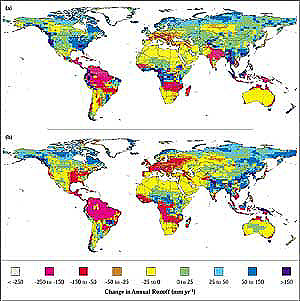4.3.6.2. Effects of Climate Change on River Flows

Figure 4-1: Change in average annual runoff by 2050 under HadCM2 ensemble
mean (a) and HadCM3 (b) (Arnell, 1999b). |
By far the majority of studies into the effects of climate
change on river flows have used GCMs to define changes in climate that are applied
to observed climate input data to create perturbed data series. These perturbed
data are then fed through a hydrological model and the resulting changes in
river flows assessed. Since the SAR, there have been several global-scale assessments
and a large number of catchment-scale studies. Confidence in these results is
largely a function of confidence in climate change scenarios at the catchment
scale, although Boorman and Sefton (1997) show that the use of a physically
unrealistic hydrological model could lead to misleading results.
Arnell (1999b) used a macro-scale hydrological model to simulate streamflow
across the world at a spatial resolution of 0.5°x0.5°, under the 1961–1990
baseline climate and under several scenarios derived from HadCM2 and HadCM3
experiments. Figure 4-1 shows the absolute change in annual
runoff by the 2050s under the HadCM2 and HadCM3 scenarios: Both have an increase
in effective CO2 concentrations of 1% yr-1. The patterns
of change are broadly similar to the change in annual precipitation—increases
in high latitudes and many equatorial regions but decreases in mid-latitudes
and some subtropical regions—but the general increase in evaporation means
that some areas that see an increase in precipitation will experience a reduction
in runoff. Alcamo et al. (1997) also simulated the effects of different climate
change scenarios on global river flows, showing broadly similar patterns to
those in Figure 4-1.
Rather than assess each individual study, this section simply tabulates catchment-scale
studies published since the SAR and draws some general conclusions. As in the
SAR, the use of different scenarios hinders quantitative spatial comparisons.
Table 4-2 summarizes the studies published since the SAR,
by continent. All of the studies used a hydrological model to estimate the effects
of climate scenarios, and all used scenarios based on GCM output. The table
does not include sensitivity studies (showing the effects of, for example, increasing
precipitation by 10%) or explore the hydrological implications of past climates.
Although such studies provide extremely valuable insights into the sensitivity
of hydrological systems to changes in climate, they are not assessments of the
potential effects of future global warming.
It is clear from Table 4-2 that there are clear spatial
variations in the numbers and types of studies undertaken to date; relatively
few studies have been published in Africa, Latin America, and southeast Asia.
A general conclusion, consistent across many studies, is that the effects of
a given climate change scenario vary with catchment physical and land-cover
properties and that small headwater streams may be particularly sensitive to
change—as shown in northwestern Ontario, for example, by Schindler et al.
(1996).
|